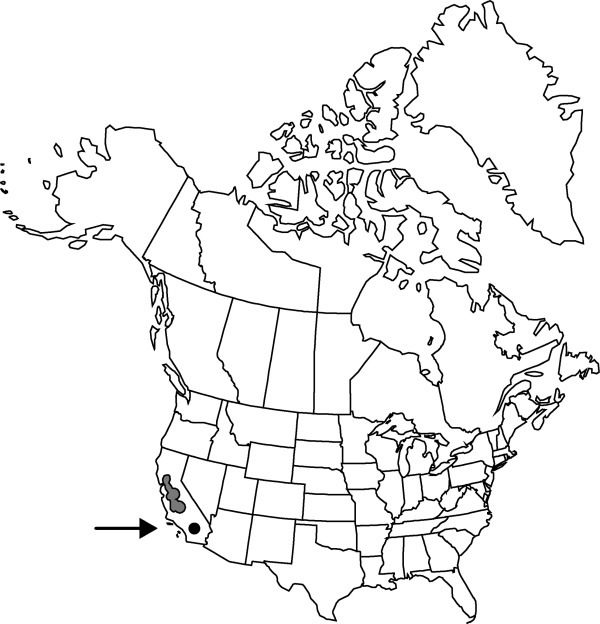Difference between revisions of "Atriplex coronata"
Proc. Amer. Acad. Arts 9: 114. 1874.
FNA>Volume Importer |
FNA>Volume Importer |
||
| Line 12: | Line 12: | ||
|name=Atriplex elegans var. coronata | |name=Atriplex elegans var. coronata | ||
|authority=(S. Watson) M. E. Jones | |authority=(S. Watson) M. E. Jones | ||
| − | }}{{Treatment/ID/Synonym | + | }} {{Treatment/ID/Synonym |
|name=Obione coronata | |name=Obione coronata | ||
|authority=(S. Watson) Ulbrich | |authority=(S. Watson) Ulbrich | ||
| Line 28: | Line 28: | ||
|distribution=Calif. | |distribution=Calif. | ||
|discussion=<p>Varieties 3 (3 in the flora).</p><!-- | |discussion=<p>Varieties 3 (3 in the flora).</p><!-- | ||
| − | --><p>Although placed within the Atriplex argentea species complex by P. C. Standley (1916), this taxon appears more nearly allied to A. cordulata, differing mainly in leaf shape, round-ovate or deltoid-ovate to elliptic or lanceolate (not ovate to cordate-ovate), and markedly tuberculate faces of the fruiting bracteoles.</p> | + | --><p>Although placed within the <i>Atriplex argentea</i> species complex by P. C. Standley (1916), this taxon appears more nearly allied to <i>A. cordulata</i>, differing mainly in leaf shape, round-ovate or deltoid-ovate to elliptic or lanceolate (not ovate to cordate-ovate), and markedly tuberculate faces of the fruiting bracteoles.</p> |
|tables= | |tables= | ||
|references= | |references= | ||
| Line 71: | Line 71: | ||
|publication year=1874 | |publication year=1874 | ||
|special status= | |special status= | ||
| − | |source xml=https://jpend@bitbucket.org/aafc-mbb/fna-data-curation.git/src/ | + | |source xml=https://jpend@bitbucket.org/aafc-mbb/fna-data-curation.git/src/8f726806613d60c220dc4493de13607dd3150896/coarse_grained_fna_xml/V4/V4_699.xml |
|genus=Atriplex | |genus=Atriplex | ||
|subgenus=Atriplex subg. Obione | |subgenus=Atriplex subg. Obione | ||
Revision as of 18:30, 18 September 2019
Herbs, erect or decumbent, 0.5–6 dm; branches terete, fructiferous almost to base, scurfy when young. Leaves alternate, subsessile or proximal short petiolate; blade ascending, oblong, oblong-ovate, or lanceolate to elliptic, 5–40 × 2–10 mm, thin, base acute to obtuse, margin entire, apex acute to acuminate. Flowers of both sexes in small axillary glomerules, 5-merous. Fruiting bracteoles almost sessile, broadly cuneate, 2–5 × (2–)2.5–5 mm, united to summit, truncate at summit, sides smooth or obscurely tuberculate. Seeds light brown to amber, 1–1.5 mm. 2n = 36.
Discussion
Varieties 3 (3 in the flora).
Although placed within the Atriplex argentea species complex by P. C. Standley (1916), this taxon appears more nearly allied to A. cordulata, differing mainly in leaf shape, round-ovate or deltoid-ovate to elliptic or lanceolate (not ovate to cordate-ovate), and markedly tuberculate faces of the fruiting bracteoles.
Selected References
None.
Lower Taxa
Key
| 1 | Stems ± erect; body of fruiting bracteoles ± semicircular in profile, compressed or ± spheric; tubercles dense; marginal teeth ± equal. | Atriplex coronata var. notatior |
| 1 | Stems decumbent to ascending; body of fruiting bracteoles approaching circular or flabellate in profile, ± compressed; tubercles usually few; marginal teeth unequal | > 2 |
| 2 | Fruiting bracteoles 2-4 mm; basal branches and leaves typically opposite. | Atriplex coronata var. vallicola |
| 2 | Fruiting bracteoles (2-)4-5 mm; basal branches and leaves typically alternate | Atriplex coronata var. coronata |
